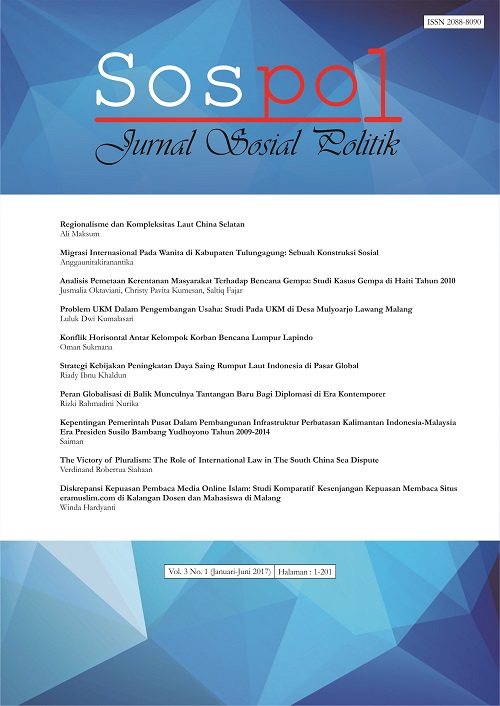Analisis Pemetaan Kerentanan Masyarakat Terhadap Bencana Gempa: Studi Kasus Gempa di Haiti Tahun 2010
DOI:
https://doi.org/10.22219/sospol.v3i1.4400Abstract
Abstrak
Haiti terletak di Pulau Hispaniola, yang merupakan perbatasan antara lempeng tektonik Amerika dan Karibia. Lempeng ini bergerak sekitar 2 sentimeter per tahun, sehingga termasuk seismik aktif dan memiliki sejarah gempa yang panjang. Namun, dengan sejarahnya yang sering terkena gempa, tidak membuat negara ini menjadi siap terhadap gempa. Pada tahun 2010, gempa yang cukup besar, dengan skala sekitar 7 SR menerpa Haiti. Korban jiwa yang diakibatkan oleh gempa tersebut mencapai 100.000 hingga 300.000 jiwa. Menurut UN General Assembly, kerugian total akibat gempa bumi diperkirakan mencapai USD 7.8 milyar, yang berarti setara dengan lebih dari 120 persen GDP Haiti di tahun 2009. Melalui tulisan ini, peneliti ingin mengetahui bagaimana analisis kerentanan masyarakat Haiti terhadap bencana alam, terutama gempa, karena dengan skala yang sebenarnya tidak terlalu besar (7 SR), gempa tahun 2010 tersebut menelan begitu banyak korban jiwa. Penelitian ini menggunakan metode penelitian kualitatif dengan teknik pengumpulan data documentary analysis. Penelitian ini menunjukkan bahwa bencana alam mempunyai beberapa dimensi, dan membutuhkan penanganan komprehensif agar jumlah korban jiwa akibat gempa bisa ditekan dan diminimalisir oleh pemerintah.
Kata Kunci: bencana alam, gempa, kerentanan masyarakat.
Abstract
Haiti is located on the island of Hispaniola, which is the border between America and Caribbean tectonic plates. These plates move about 2 centimeters per year, thus including seismically active, has a long history of earthquakes. However, as a land which often affected by the earthquake, this state is not ready against earthquakes. In 2010, an earthquake, about 7 SR scale hit Haiti. The loss of life caused by the earthquake reached 100,000 to 300,000. According to the UN General Assembly, a total loss due to the earthquake is estimated at USD 7.8 billion, which would be equivalent to more than 120 percent of Haiti's GDP in 2009. By this article, the researchers probe the Haiti’s community vulnerability analysis towards natural disasters, particularly earthquakes, because the actual scale of the earthquake itself is not enormous, only 7 SR of 10 SR, however the earthquake in 2010 swallowed so many losses. This study uses qualitative research methods with data collection techniques documentary analysis. The result shows that a natural disaster has several dimensions, and requires a comprehensive action so that the number of casualties caused by the earthquake can be suppressed and minimized by the government.
Keywords: natural disasters, earthquakes, community vulnerabilityDownloads
Downloads
Published
How to Cite
Issue
Section
License
Authors who publish with this journal agree to the following terms:
- Authors retain copyright and grant the journal right of first publication with the work simultaneously licensed under a Creative Commons Attribution-ShareAlike 4.0 International License that allows others to share the work with an acknowledgement of the work's authorship and initial publication in this journal.
- Authors are able to enter into separate, additional contractual arrangements for the non-exclusive distribution of the journal's published version of the work (e.g., post it to an institutional repository or publish it in a book), with an acknowledgement of its initial publication in this journal.
- Authors are permitted and encouraged to post their work online (e.g., in institutional repositories or on their website) prior to and during the submission process, as it can lead to productive exchanges, as well as earlier and greater citation of published work (See The Effect of Open Access).

This work is licensed under a Creative Commons Attribution-ShareAlike 4.0 International License.



















